Trending
Opinion: How will Project 2025 impact game developers?
The Heritage Foundation's manifesto for the possible next administration could do great harm to many, including large portions of the game development community.
Rumors around a sixth color have been around for decades, but would it really be a good idea?


The following article is a reproduction, and has been modified for this site. The original article, and many more, can be found at RemptonGames.com
Hey everybody! Today’s topic is one that I am extremely interested in talking about. What would happen if Magic: The Gathering added a sixth color?
Before we jump into it, let’s start with a little background. Magic: The Gathering is a trading card game – actually the world’s first trading card game – that was originally released in 1993. In this game players take on the role of a powerful wizard known as a planeswalker, who has the power to travel across different planes of existence, summon powerful creatures from across space and time, and cast mighty spells.
From a gameplay perspective, players buy cards from randomized packs, and use them to build customized decks. Then, they use these decks to battle their opponents, and try to bring their opponent’s life from 20 down to 0. Magic has been around for over 25 years, and is still going strong with millions of players around the world.
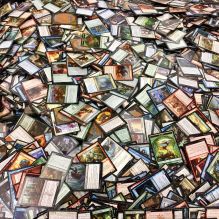
I can quit anytime I want…
From a game design standpoint, Magic is a very impressive game. It is a game that supports a wide variety of different ways to play, and has been able to keep player’s attention for decades. While there are many reasons for Magic’s success, one of the most important and powerful ideas that underpins the entire game is a concept known as the “Color pie”.
Basically, pretty much every card in Magic is one (or more) of these five colors – white, blue, black, red, or green. Each of these different colors represents a different type of magic, and requires a different type of magical energy, called Mana, to play. Each color has its own identity both from a gameplay and a philosophical standpoint, and each color has its strengths and weaknesses.
Because different colors require different types of mana to use, it creates a very interesting type of tension in the gameplay. Because each color is limited in what it can do, players are incentivized to play more colors to cover their weaknesses. However, since each color requires different mana to play, it is easier and more reliable to build a deck with fewer colors, to guarantee that you will actually have the mana to play the cards you want to play.
This system is at the core of Magic’s design, and ever since it was released it has always had the same five colors. However, throughout the years there has been speculation and rumors about a sixth color. While so far Magic has never revealed a new color, it does beg the question – what would happen to the game if they did? Would a new color add new layers of depth and help the game reach even greater heights of popularity, or would it crumble the foundation of the game and lead to it’s downfall? Let’s find out!
Before we can figure out what adding a sixth color would do to the color pie, we should first dig a little deeper into how the color pie currently works. Let’s start by getting to know each color a little better.
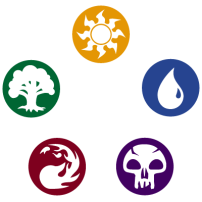
People always ask “what do the colors do” but never “how are the colors doing?”
First up is white – the color of community, structure, and order. White cares about equality and fairness, and believes that everybody should be protected and taken care of. White draws its power from the Plains, and can commonly be seen casting spells to protect its creatures, gain life, and remove threats that don’t fit it’s idea of the perfect community. Common white creatures include humans and angels.
Next is blue – the color of knowledge and ambition. Blue cares about learning and self-improvement, and believes that anybody can become anything they want through hard-work and perseverance. Blue mana comes from Islands, and examples of blue spells include drawing cards and countering your opponent’s spells. Popular blue creatures include Merfolk and Sphinxes.
Third is black – a very self-centered and manipulative color that is willing to do whatever it takes to achieve its goals. Black believes that the only person that truly has your best interests in mind is you, and therefore it is up to each person to take care of themselves. Black gathers strength from the swamp, and Black spells often include destroying creatures, draining life from your opponent, and making your opponent discard cards. Good examples of black creatures include zombies and demons.
The next color is red, the color of emotion and impulse. Red does what red wants, and would rather act first and think later. Red power comes from Mountains, and in battle, red is best known for their direct damage spells, random effects, and for gathering short-term advantages. Well-known red creatures include goblins and dragons.
The last color is green – the color of nature and harmony. Green believes that everything has a place in nature, and that peace and happiness come from everything following the natural order. Green mana is embodied in forests, and Green spells often make creatures larger, help players gather more mana, or destroy unnatural things such as artifacts.
Whew, that was a lot. However, understanding the colors that already exist is necessary to understand what we would have to do to add a sixth color. Specifically, in addition to actually picking a color, we would need to come up with a new form of land to support it, a new philosophy to define it, and a new mechanical identity that doesn’t conflict with the existing 5 colors.
The idea of a sixth color goes all the way back to an article in the February 1997 issue of Inquest magazine, a popular magazine at the time which focused on Trading Card Games. This article was a prank which showed several supposedly new cards in a never-before-seen color – purple. According to this article, the purple land was going to be a “Portal” , and the example cards had a number of interesting effects that mostly connected to blue and artifact abilities, with a more black art direction.
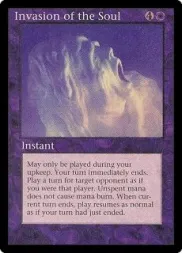
Even as a prank, they still made Mindslaver less broken
Even though this article was just a prank, Purple has become almost ubiquitous as the mythical sixth color in Magic: The Gathering. While there is no guarantee that a sixth color would have to be purple – it could be Orange, Yellow, Brown, Gray, or Pink, for the rest of this video I am going to be using the terms purple and sixth color interchangeably.
Purple also seems like a good option because (aside from one small exception which I’ll talk about soon) the color Purple currently doesn’t mean anything in Magic. Aside from the five colors Magic also used to have artifacts in a Brown frame and the current artifact frame is grey, which makes those two colors unlikely. The frame for multicolored cards is also gold, which could potentially make yellow or orange confusing. Purple is a common color, and would be easily distinguishable from the others for most players.
In fact, this connection between a hypothetical sixth color and the color purple is so strong, that in the one instance that Magic actually considered adding a sixth color Purple was the color they chose. Yes, There was actually a point in time where Magic actually almost added a sixth color. It was during the design of a set called Planar Chaos, back in 2005 – 2006.
Planar chaos is the second set in a group of sets known as the Time Spiral block. The Time Spiral block takes place during an apocalyptic event on the Magic plane of Dominaria. Time is unravelling, and potentially the entire multiverse is in danger. These sets had a very strong time theme, and each set was associated with a different period in time – the past, the present, and the future. To show these themes, each set included a number of “timeshifted” cards – cards from a different time.
The first set, Time Spiral, had cards from Magic’s past. The Third set, Future Sight, had cards from “potential futures”. Planar Chaos was the middle set, and had cards from an “alternate present”.
How do you represent an alternate present in a trading card game? Well, one way is to imagine a way that the game could have evolved, but didn’t. An alternative path that was equally likely, but different than the way the game ended up.
The solution they ended up going with was releasing a series of color-shifted cards – popular cards from previous magic sets, but in a different color that they wouldn’t normally be printed in. While this decision is reportedly still causing the designers headaches because of the color pie issues that it created, during design they actually considered an even more radical path.
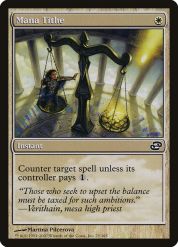
“See, White CAN get counterspells!”
One possibility they considered for Planar Chaos was to do a sixth color, just for that set. This would strongly convey the idea of an “alternate reality” – it’s entirely possible that Magic could have had a different number of colors at the beginning, it just ended up being 5.
The idea behind adding Purple in Planar Chaos specifically was also the fact that it would not have to be an ongoing thing. Since Planar Chaos was an alternate reality, they could freely return to the five color paradigm once the set was over. However, if it was popular enough maybe it could be brought back later….
The first question that had to be answered if you want to add a new color to the color pie is – where do you put it? You see, the color pie is not simply a collection of individual colors, but also defines the relationships between the colors. Each color has two neighbors that are considered its allies, and two colors across from it that are its enemies. Adding a new color would completely change the relationships between the colors, and could totally skew the rest of the color pie.
Much like the Inquest article before, the Planar Chaos designers decided to place Purple between Blue and Black. This decision has ripple effects that totally change the relationships between the colors. Because purple is now allies with blue and black, those two colors are no-longer allies with eachother. In addition, Green and Blue are no longer enemies, but Green and Purple are.
In fact, instead of each color having 2 allies and 2 enemies, the new relationships are 2 allies (it’s neighbors), 2 neutral colors (colors 1 space away), and 1 enemy each. Because each color now only has one enemy, this arrangement would likely cause a much larger focus to be placed on the enemy conflicts – white vs black, red vs blue, and green vs purple.
Speaking of 2 color pairs, this would also change the number of potential color combinations that a player has to work with. Currently Magic has 10 2 color combinations (the Ravnica Guilds), 10 3 color combinations (the Alara Shards and Tarkir Clans), and 5 4 color combinations. Adding a sixth color would now result in 15 2 color combinations, 20 3 color combinations, 15 four color combinations, and 6 five color combinations. Since Magic sets tend to have build in strategies for each color pair, this would dramatically complicate the design of the set.
This would also have a dramatic effect on deckbuilding. In Magic there are two main ways to play – constructed and limited. In a constructed format, players are allowed to build their decks ahead of time using any cards that are allowed in that particular format. In limited formats, players are given a limited number of cards before they play, and are required to build their decks on the spot from them. Adding a sixth color would have different effects on both types of formats.
From a constructed standpoint, purple would have a difficult time, at least at first. While players might be initially curious about the new color, it would be difficult to justify playing a Purple deck competitively because your options would be so much more limited. While Magic has been changing the way they release Standard sets several times over the past couple of years, I believe that under the current format players of the original five colors would have 5 or 6 sets worth of cards to choose from, while Purple players would only have 1, at least at first.

Well that just clears everything up, doesn’t it
Not only would they only have 1 set worth of cards to choose from, but they get a smaller slice of that set. As sets try to remain evenly balanced between all 5 colors, each color gets around 1/5th of a set. If you add a sixth color, each color now only gets 1/6 of a set. With such a limited set of cards to pull from, it would be very difficult for Purple to compete in constructed for the first couple of years after being released. If you are only releasing it for a single set, such as the plan in Planar Chaos, this situation gets even worse.
Of course, there are ways to counteract some of these effects. The most obvious way to incentivize players to play Purple would be to make Purple really powerful, at least at first. However, this strategy is dangerous, because it risks warping the entire competitive landscape around one color. If Purple is both the new, exciting thing and the most powerful thing, then that could lead to an overabundance of purple decks and could cause severe damage to Competitive Magic.
Another potential way is to skew the first couple of purple sets so that they do not have an even number of cards of each color, but have significantly more purple cards. This could avoid making Purple overpowered, and would help give Purple players more options if they want to build a deck. While all the other colors would be underrepresented in that particular set, that wouldn’t be too bad for constructed formats, and if handled carefully (and adjusting the ratios over time to eventually reach an equilibrium) this strategy could work for constructed.
Of course, such a strategy would be disastrous for limited. Suppose that, in order to give enough options for constructed, designers made half of the cards in the set Purple. This means that, in limited formats, half of your very limited resources for deckbuilding are purple cards. This would basically require that every limited player played Purple, along with another color or two.
Of course, even if the ratios of each color remained even it would still have an effect on limited that would need to be carefully balanced. Each color would make up a smaller fraction of your potential pool of cards, which would make it more difficult to construct a 2 color deck. This would probably require players to play 3 color decks instead, which would require the set to be designed to support this.
All of these consequences would occur before we even define what the color is! While we have been using purple as our example, any new color placed anywhere within the color pie would cause similar results.
However, if we were actually adding a sixth color we couldn’t just stop there – we would actually have to define what the color is, where it goes, what it can do, and what it stands for. For now we will stick with Purple between Black and Blue, but we still have to define what this color means. In his article “The Color Purple”, Paul Sottosanti breaks down a couple of the possibilities.
One possibility would be to give Purple the ability to do almost anything, but not be the best at anything. However, this possibility would make Purple seem weak, since all of the individual cards would seem underpowered (even if the color itself was quite versatile). The second possibility would be to give it a bunch of random abilities that none of the other colors are really using.
The problems with this are two-fold – first, Magic has been around for 25 years, and it would be next to impossible to find enough abilities that aren’t already associated with a color to fill an entirely new color. Second, even if it were possible to come up with enough abilities they would likely be a. bad (which is why that ability wasn’t being used in the first place) and b. not cohesive with one another because they were never intended to go together.
The third possibility would be to completely reshape the current color pie with the addition of purple, taking some abilities away from other colors and giving them to Purple based on their newly established philosophies. This could work, but would certainly have side-effects. Depending on the changes that were made, the original five colors would now have numerous older cards that no-longer fit their slice of the color pie. While this is already true, because the color pie is constantly changing over time, there has never been such a big shift all at once (except, ironically, in Planar Chaos).
Finally, the fourth possibility that was explored during Planar Chaos design was to give Purple an identity that was connected to Time, and give it a bunch of time-manipulation abilities. This is actually the direction that I like the most, and while it may seem like this type of identity could only work in a time-based set like Planar Chaos, I actually don’t think this is the case. No matter what, the addition of a sixth color would be a huge shift in the multiverse of Magic, and would need some sort of wibbly-wobbly, timey-wimey explanation to explain where it came from. I also think that this is the direction that would allow Purple to have its own strong identity without eating into the other colors.
Due to all of the constraints that adding a new color would create for the set, the idea was eventually dropped for Planar Chaos. However, there are still several ways that a new color could be added to the game. I firmly believe that there will never be a new color in Standard-legal Magic, not only due to all of the development issues I have already mentioned, but also because of the one thing that Magic: The Gathering will never, ever, ever change – the card-back.
Magic’s card back has remained the same ever since the original set, Alpha, was released in 1993. This card back features Magic’s logo, the color pie, and the “Deckmaster” logo. The Magic logo is outdated, the Deckmaster brand no longer really exists, and there is even an accidental pen mark that can be found on the back of every Magic card, but even so it refuses to change. Adding a sixth color would likely require them to change the card back to reflect the new color pie, although it’s also possible that Wizards of the Coast could just be stubborn and have everything on the back of the card be out-of-date.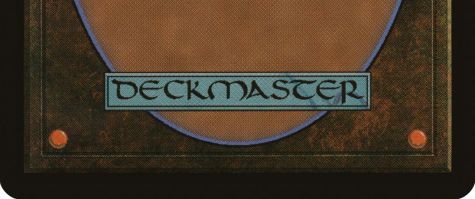
However, even if it would never be released in a tournament legal Magic set, there are still other ways it could happen. One way is through a supplemental set, where the cards are only legally allowed to be played with other cards from that set. In the past Magic has released several different supplemental sets that added brand-new types of cards to the game, such as Vanguards, Schemes, Planes, and Phenomena. Some of these, such as the Archenemy Schemes, do have different backs from normal magic cards. This leaves a new color within the realm of possibility, if only temporarily.
The second place a new color could be added is actually the place where new colors already exist – silver bordered Un-sets. The Un-sets are a series of comedic Magic sets full of jokes, references, and weird mechanics that could never be done in a normal Magic set. Lo and behold, un-sets already have cards that reference extra colors.
The first of this was a card called Water Gun Balloon Game, which allows players to create a Pink Giant Teddy Bear creature token. Another card, Avatar of Me, has a color that is the player’s eye color. This opens up the possibilities to include colors such as brown, grey, or Hazel. Finally, a card in the most recent un-set allows players to create a Gold dragon token. It is entirely possible that more un-cards will be created that deal with colors outside of the ordinary, and there could even be a larger focus on these unusual colors.
However, for now all of this is just hypothetical, and clearly adding a sixth color is not as simple as it may have seemed. I guess for now we will just have to wait and see! However, this brings me to my question of the day – what Magic colors are you? What color, or set of colors, do you think most closely describe your personality? Personally, I think I would be White, blue, and black. Let me know what you think in the comments down below.
That is all I have for this week. If you enjoyed this article, check out the rest of the blog and subscribe on Twitter, Youtube, or here on WordPress so you will always know when I post a new article. If you didn’t, let me know what I can do better in the comments down below. And join me next time, where I will be taking a look at the dungeon design in Ocarina of Time!
Read more about:
BlogsYou May Also Like